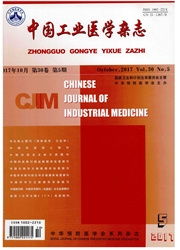

 中文摘要:
中文摘要:
目的通过对脉搏信号特征的提取与分析,寻找诊断与评测VDT视觉疲劳状态的客观指标。方法由问卷调查表选定37例健康被试者,设计视觉疲劳实验。在VDT实验前后,分别采集被试者光电脉搏信号,并对被试者进行疲劳症状问卷调查和闪光融合频率计测定以及体温测量。对脉搏信号进行时域和频域分析,提取波形高度和功率谱峰值作为特征参量。结果通过对疲劳症状问卷的统计分析发现,以Rechichi提出的判断标准,视疲劳实验后,被试者均处于视疲劳状态。闪光融合频率值下降显著(P〈0.05),同时体温下降显著(P〈0.01)。视疲劳后脉搏信号的波形高度和功率谱峰值均显著降低(P〈0.001)。结论脉搏信号的波形高度和功率谱峰值能够较客观地反映人体VDT视疲劳状态,有望作为视疲劳状态诊断与评测的客观指标。
 英文摘要:
英文摘要:
Objective To search the objective indices for diagnosing and assessing visual fatigue induced by VDT(visual display terminal)through analyzing the pulse wave signals.Methods Thirty-seven healthy volunteers were selected by questionnaire for experiment of visual fatigue induced by VDT.The pulse signals of subjects were examined by photoplethysmography,the visual fatigue was evaluated by the questionnaire,meanwhile,measured the critical flicker frequency(CFF)and body temperature,before and after VDT-watching experiment,respectively.Results According to Rechich's judging criterion,the data of questionnaire demonstrated that all the subjects were in visual fatigue status after the VDT-watching experiment,the values of CFF and body temperature were significantly decreased,and the height of pulse waveform and the peak value of power spectrum were all decreased significantly after VDT experiment(P0.001).Conclusions The results suggested that the height of pulse waveform and the peak value of power spectum could be used as the diagnostic indicators of visual fatigue in VDT workers.
 同期刊论文项目
同期刊论文项目
 同项目期刊论文
同项目期刊论文
 期刊信息
期刊信息
